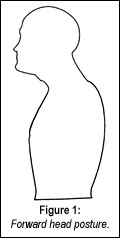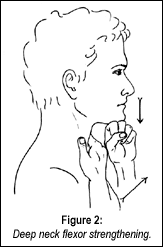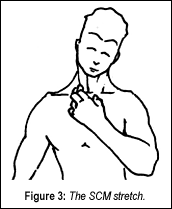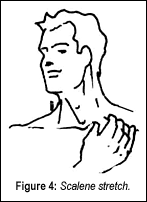To complete our series on the cervical spine, let's talk about the musculature. Helping chronic neck problems requires a normalization of posture, which in turn requires normal muscle tone.
We love to adjust the spine. Teaching rehabilitation is a bit less glamorous and inherently slower. We move from the "Fix me, Doc" model to patients taking on their own healing. If patients take the responsibility to do the work, they can reap lifelong benefits. An excellent article on this topic by Craig Liebenson is in the January 2 edition of the Journal of Bodywork and Movement Therapy. Dr. Liebenson does an excellent job with the material that we discuss here, with great literature references, and a more detailed progressive version of how to reactivate the deep neck flexors.
The major postural neck pattern is the "chin-poke," what Janda calls the "upper-crossed syndrome." These patients lead with their chins, which is especially obvious when they are sitting or getting out of a chair. Sitting at a computer all day is especially hazardous to these folks.
Instead of a gentle cervical lordosis, the upper cervical spine is hyperextended, leading to suboccipital tension, potential headaches or other upper cervical problems. The rest of the cervical curve will be absent, with the whole of the lower cervical jutting forward. This predisposes one to the anterior, lower cervical subluxation and fascial patterns, which I outlined in two previous articles (www.ChiroWeb.com/archives/20/08/06.html, and at www.ChiroWeb.com/archives/20/11/10.html).
The muscles pulling the neck forward are primarily the scalenes and SCM, which will be hypertonic and tight. These muscles are unopposed by the deep neck flexors, the longus colli and longus capitus, which are inhibited and weak.
Neck posture does not begin in the neck. People who slump when they sit inevitably jut their necks forward. The pattern begins in the low back, with a lack of spinal stabilization muscle activity; continues into the lower thoracics with an excessive kyphosis and the apex inferior to T7; and shows up in the upper thoracics as a flattening, with loss of activity of the scapular stabilizers.
I am going to give you three practical, key exercises. I've found that the principles that we apply in "framework low-force adjusting" also apply to appropriate rehab. The principle of working at the soft edge of the barrier is applied to stretching (for much improved results), and to decrease the risk of patients injuring themselves. Effective stretching is gentle and stops at the first resistance or barrier, then is held until the body "lets go." Overstretching just activates the stretch reflex and tightens the muscles. Accuracy is also critical here. Often the bigger muscles are overactive, and the smaller tonic muscles are inhibited. Our goal is a subtle retraining on a subcortical level.
Deep Neck Flexor Strengthening
One can strengthen and tone the deep neck flexors with a deceptively simple exercise. This is a difficult muscle to assess; the posture of chin poke tells you the patient needs this.
- Start with both of your hands under the patient's chin.
- With the fist of one hand, provide resistance to the patient pushing the chin inferior. This motion is not quite isometric, but has a very limited range. The patient will use this fist as a fulcrum to simultaneously lift the sternum and tuck the chin, both done gently.
- The other hand wraps around the front of the neck, and the patient can use the fingers and thumb to monitor the more superficial sternocleidomastoid (SCM) and scalenes. If these fire or tighten, they are using the wrong muscles to flex the neck.
- Hold this gentle contraction for 15-30 seconds, and repeat several times per day.
The sensation is that of lifting. Sometimes I have the patient imagine two balloons: one lifting the sternum; the other lifting the crown. This is a strengthening exercise, but is not done maximally. We are attempting to activate the deep neck flexors, tonic muscles designed to work for long periods. The level of activation is 10-25 percent of the maximum, just enough to posturally lift without activating the overactive synergists of the SCM and scalenes.
Neck Stretches
We also usually need to stretch the SCM and scalenes. I assess these with palpation. Are they tight and tender? I have seen many versions of these stretches, and have not been satisfied that they are effective. These are my own variations. The key is using the lower hand as a fulcrum, or to tether the muscle to allow an effective stretch without excessive range of motion. (You can download handouts with pictures of the SCM stretch from my website at www.drmarcheller.com/scm_stretch.htm. You really need to make sure you understand these stretches yourself before you teach them to your patients. If not done correctly, stretches are useless.)
The following four-step, self-stretch exercise is a bit complicated. I wish it were simpler, but once the patient understands it, it works great.
Stretching the Right SCM
- Using your left hand, pinch the right SCM between your thumb and first two fingers, either just above the clavicle, or where it feels tightest. The SCM is a large diagonal muscle, about the width of your thumb, and is quite superficial.
- Tuck the chin and lift the sternum. This is the same motion as in the neck flexor strengthener, described above.
- Turn the head about 20 degrees toward the right.
- Final step: While maintaining all of the other positions, tip the head toward the left. Pull down gently on the SCM with the pinching hand and keep the chin tucked. You should feel the stretch strongly under your pinching hand.
Hold the stretch for 30-60 seconds, with two repetitions, or gradually go in and out of the stretch position. Do two or more times per day.
The following is another exercise that can be self-applied and taught to your patients.
Stretching the Left Scalenes
- Tip your head to the left to relax the muscle. Use your right hand: either the edge of your fingers or your thumb. Find the tight part of the muscle by sliding your hand up above and then behind the collar bone. Push down to tether or hold the muscle down.
- Keep your chin tucked. Tip (side-bend) your head to the right. You can tip your head back a little if it helps. Try rotating your head toward or away from your hand, seeing which direction gets you a better stretch to the front of your neck and engages the tight fibers. Move only until you begin to feel the stretch in the front of your neck. You don't need to sidebend your neck very far.
- Hold the stretch for 30-60 seconds. Repeat one to two times, or slowly go in and out of the stretch position, repeating three to 10 times. Do this stretch two or more times per day.
- Gently stretch; don't overdo it.
There you have it - three basic exercises for the neck. You can download the handouts from my website and use them with your patients. When taught correctly, and understood and utilized by the patient, they can make a huge difference in posture and pain patterns.
References and Resources
- Liebenson C. Functional reactivation for neck pain patients. Journal of Bodywork and Movement Therapy 2002;6(1):63-68.
- Janda. Evaluation of Muscular Imbalance, in Rehabilitation of the Spine. Williams and Wilkins, 1996.
Click here for more information about Marc Heller, DC.









